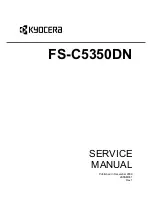
4
The control panel indicator light switches from solid amber to solid green. The display resets, and then a
line of dots appear.
5
The cooling fan turns on.
6
The fuser heater turns on.
Note:
The fuser takes longer to warm up from a cold start than a warm start.
7
The main drive motor turns on.
8
The EP drive assembly drives the developer shaft located in the imaging unit.
9
The exit rollers turn.
10
Ready
appears on the display.
If no error code is displayed, but a symptom is present, go to
“Base printer symptoms” on page 152
Fixing print quality issues
The symptoms described in this chapter might require replacement of one or more CRUs (Customer
Replaceable Units) designated as supplies or maintenance items, which are the responsibility of the customer.
With the customer's permission, you might need to install a toner cartridge.
Initial print quality check
Before troubleshooting specific print problems, complete the following initial print quality check:
•
Use only genuine Lexmark supplies. Third-party supplies may cause print quality problems.
•
The printer must be in a location that follows the recommended operating environment specifications.
See
“Operating environment” on page 311
•
Check the life status of all supplies. Any supply that is low should be replaced.
•
Load 20
‑
lb plain letter or A4 paper. Make sure the paper guides are properly set and locked. From the
control panel, set the paper size and type to match the paper loaded in the tray.
•
Print a menu settings page. Be sure to keep the original menu settings page to restore the customer’s
custom settings if needed.
•
Verify on the menu settings page if the following are set to their default values:
–
Print resolution: 600 dpi
–
Toner darkness: 8
•
Check the transfer roll for damage. Replace if damaged.
•
Check the toner cartridge and imaging unit for damage. Replace if damaged.
•
Print the print quality pages to see if the problem remains. Use Tray 1 to test print quality problems.
•
Print a print quality test page, and then look for variations in the print from what is expected. Verify if the
settings under EP Setup are set to their default values. See
.
4514-330
Diagnostics and troubleshooting
38
Summary of Contents for MS312
Page 11: ...Part number index 335 Part name index 339 4514 330 Table of contents 11 ...
Page 12: ...4514 330 Table of contents 12 ...
Page 182: ...4514 330 182 ...
Page 214: ...5 Remove the three screws B and then remove the left front mount B 4514 330 Parts removal 214 ...
Page 230: ...5 Remove the four screws B and then remove the right front mount B 4514 330 Parts removal 230 ...
Page 234: ...b Set the spring over the plunger 4514 330 Parts removal 234 ...
Page 240: ...3 Squeeze the latches B to release the left and right links B 4514 330 Parts removal 240 ...
Page 267: ...11 Disconnect the two springs D D 4514 330 Parts removal 267 ...
Page 284: ...3 Swing the right cover backward to remove 4 Remove the screw D 4514 330 Parts removal 284 ...
Page 286: ...4514 330 286 ...
Page 291: ...4514 330 291 ...
Page 293: ...Assembly 1 Covers 4514 330 Parts catalog 293 ...
Page 295: ...Assembly 2 Electronics 1 1 2 3 4 5 7 8 9 6 4514 330 Parts catalog 295 ...
Page 297: ...Assembly 3 Electronics 2 4 3 2 1 6 5 4514 330 Parts catalog 297 ...
Page 299: ...4514 330 Parts catalog 299 ...
Page 300: ...Assembly 4 Frame 2 5 6 9 10 11 13 14 12 8 1 4 4 3 7 4514 330 Parts catalog 300 ...
Page 302: ...4514 330 Parts catalog 302 ...
Page 303: ...Assembly 5 Option trays 3 4 5 6 1 2 4514 330 Parts catalog 303 ...
Page 306: ...4514 330 Parts catalog 306 ...
Page 308: ...4514 330 308 ...
Page 312: ...4514 330 312 ...
Page 314: ...4514 330 314 ...
Page 326: ...4514 330 326 ...
Page 338: ...4514 330 Part number index 338 ...
Page 342: ...4514 330 Part name index 342 ...
















































